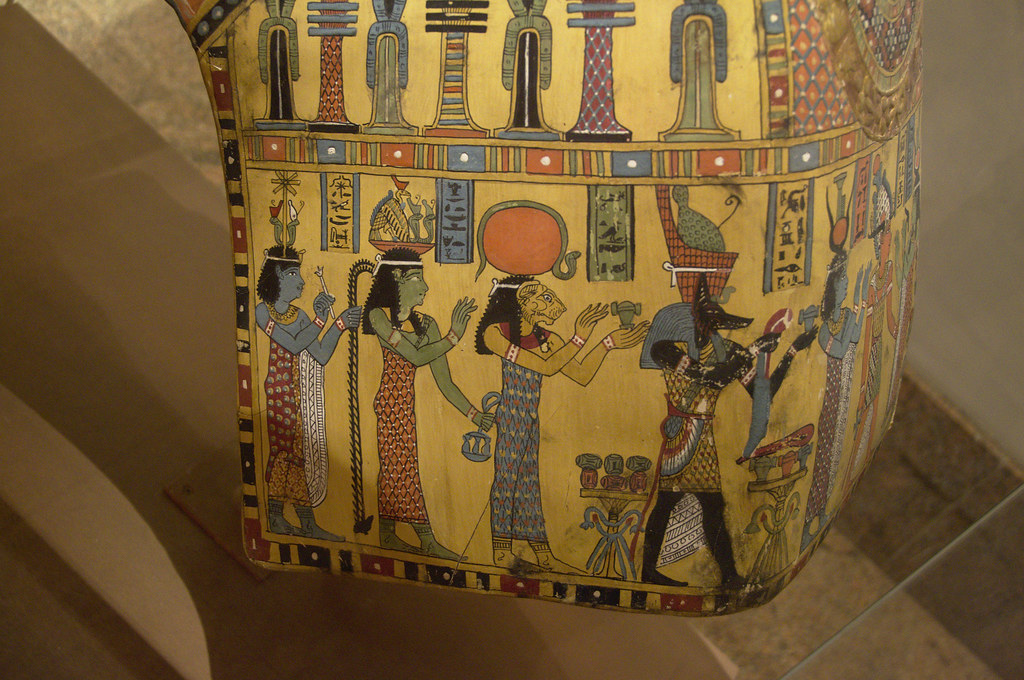Text
Beautiful shot of the mummy mask of an unnamed lady. Colourful gods parade across the yellow mask, bringing offerings: on this, the left side, we have Seshat, Hathor (wearing an elaborate headdress with a vulture wearing the red crown), Tefnut, and Anubis wearing the double crown.
(This is the same as this.)
When: Roman Egypt
Where: Metropolitan Museum of Art, New York
63 notes
·
View notes
Text
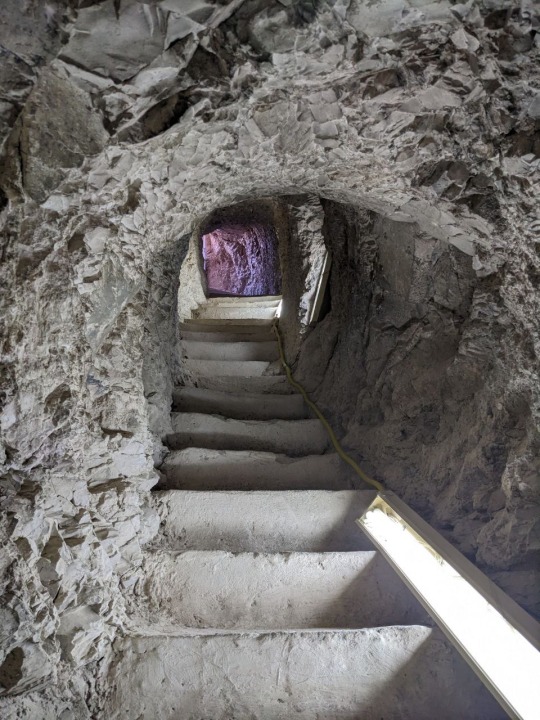
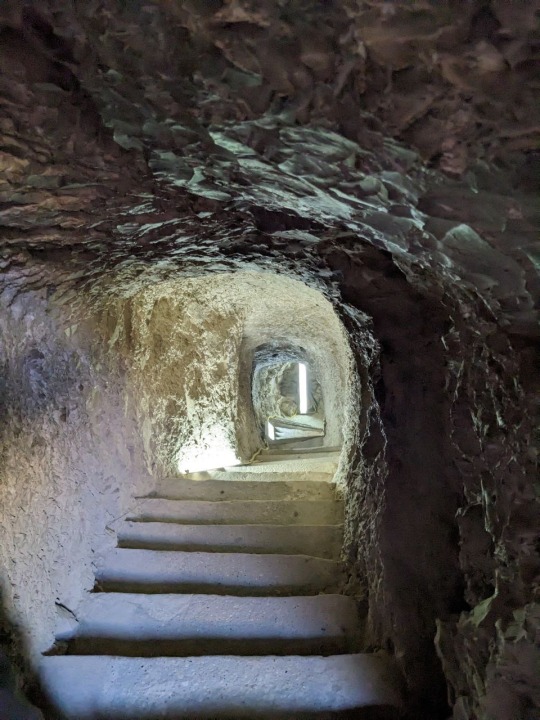

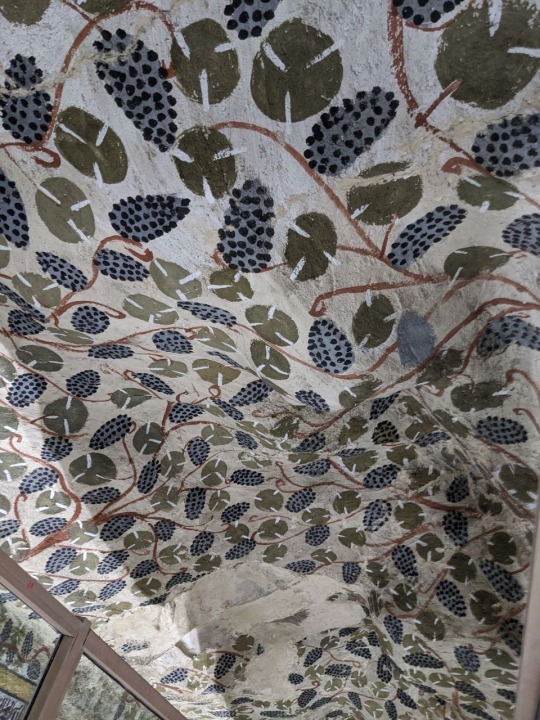


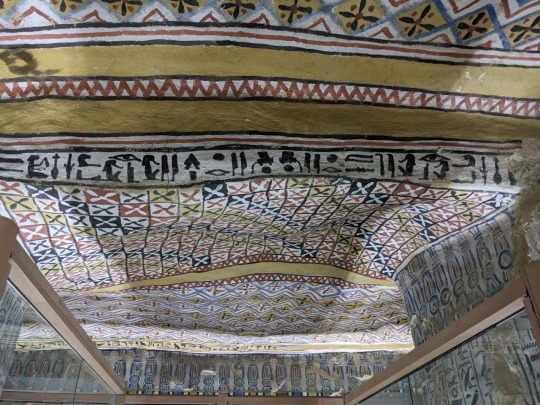
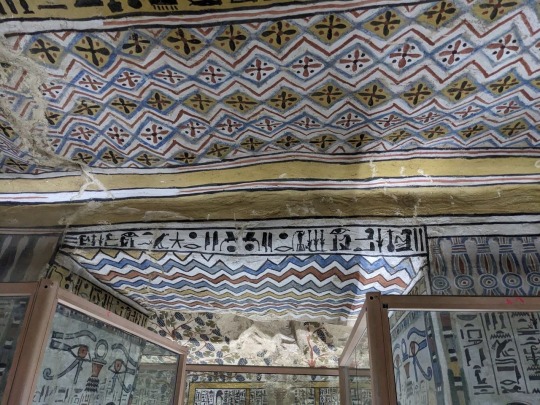
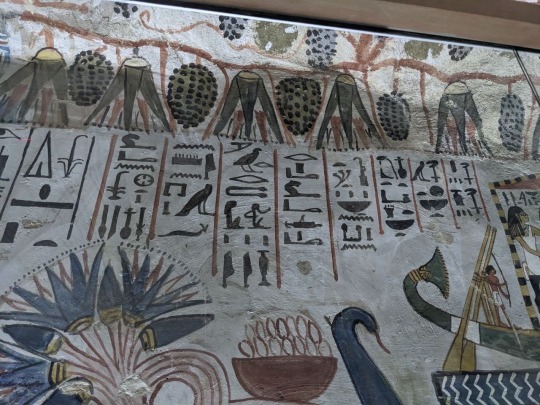

Ceiling and imagery of the Tomb of the Vineyards, burial of Sennefer, Mayor of the Southern City, Thebes, during the 18th dynasty of Egypt.
Photos taken by me, August 2023
It’s hard to tell which way is up and down when walking through the tunnel leading from the surface into the tomb. Before entering the main chamber there is a small antechamber whose ceiling is quite low, and then a shallow arch which leads to the main room depicted in the above photographs. Both chambers contain a good deal of paintings, however the main chamber holds the most numerous and well preserved paintings, of course. Besides the ceiling, everything is encased in glass.
2K notes
·
View notes
Photo

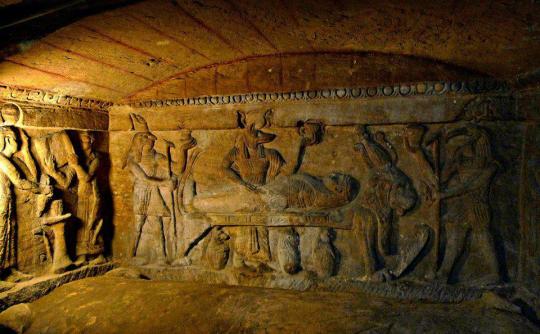
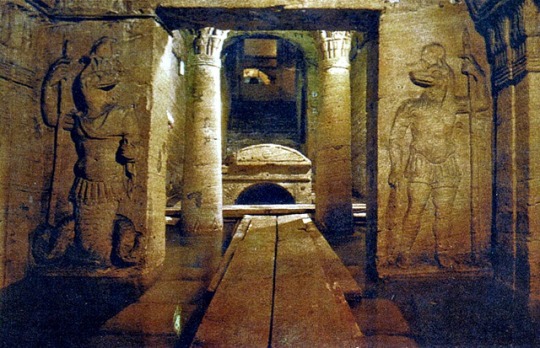
The catacombs of Kom el Shoqafa (meaning “Mound of Shards”) is a historical archaeological site located in Alexandria, Egypt and is considered one of the Seven Wonders of the Middle Ages.
The necropolis consists of a series of Alexandrian tombs, statues and archaeological objects of the Pharaonic funeral cult with Hellenistic and early Imperial Roman influences. Due to the time period, many of the features of the catacombs merge Roman, Greek and Egyptian cultural points; some statues are Egyptian in style, yet bear Roman clothes and hair style. A circular staircase, which was often used to transport deceased bodies down the middle of it, leads down into the tombs that were tunneled into the bedrock during the age of the Antonine emperors (2nd century AD). The facility was then used as a burial chamber from the 2nd century to the 4th century, before being rediscovered in 1900 when a donkey accidentally fell into the access shaft.
It is believed that the catacombs were only intended for a single family, but it is unclear why the site was expanded in order to house numerous other individuals.
2K notes
·
View notes
Text

Statuette of the God Ptah, currently residing in the Hurghada Museum in Egypt
Found in the Valley of the Kings, c. 1332-1323 BC, Tutankhamon’s reign
422 notes
·
View notes
Text
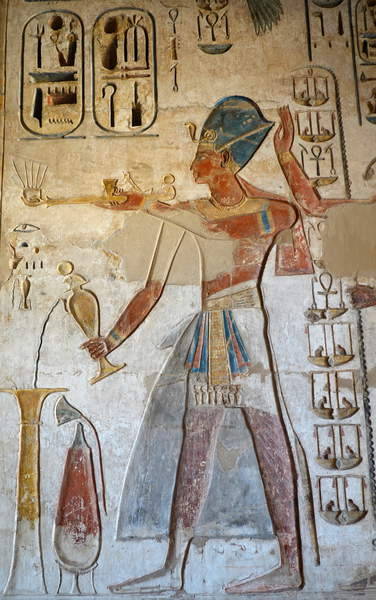
Relief of Ramesses III, Medinet Habu.
384 notes
·
View notes
Text

Statue of Akhenaten and Nefertiti
New Kingdom, 18th Dynasty, ca. 1353-1336 BC.
From Tell el-Amarna (Akhetaten).
Now in the Louvre. E 15593
Read more
200 notes
·
View notes
Text

Block Statue of Harsomtusemhat
Late Period, 26th Dynasty, ca. 664-525 BC.
Polished basalt. 43.5 cm x 19 cm x 29.5 cm.
National Archaeological Museum, Madrid. Inv. 2014
Sistrophorus block statue, showing Harsomtusemhat sitting on a socle, with his legs grouped and the hands on his knees. Before the arms and between the legs, the man is holding the sesheshet sistrum, with the face of the goddess Hathor and the monumental gate in raised relief.
This statue was meant to be placed inside a temple. It portraits an old man with realistic features and expressive look, following the style of the Saite period. The owner was a high ranking official and priest, who lived in the Memphite area, as shown by his titles, and by another statue of his found in the temple of Ptah.
Read more
51 notes
·
View notes
Text

Statues of Amun and Mut
From the Temple of Amun-Re at Karnak.
Egyptian Museum, Cairo. JE 99064
Read more
165 notes
·
View notes
Text
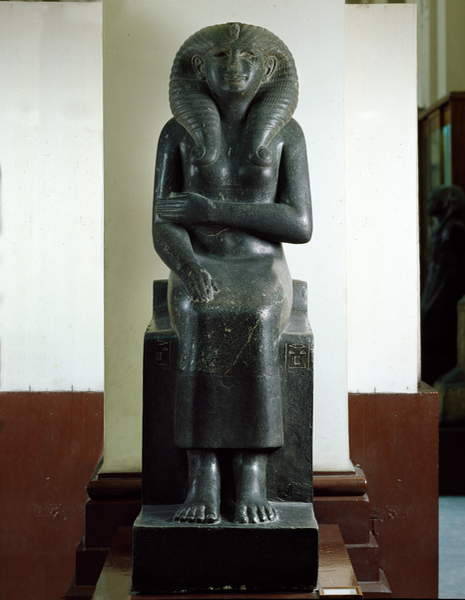
Statue of Queen Nofret
Middle Kingdom, 12th Dynasty, ca. 1897-1878 BC.
Now in the Egyptian Museum, Cairo. JE 37487; CG 381
In this statue, Queen Nofret is shown seated on a throne, wearing a wig known as a Hathor wig, which has three separate tresses of hair. A large tress falls behind the head, while two wavy tresses are pulled to the front and wrapped in narrow bands, which end over the breasts in two spirals that encircle disks. A uraeus of rearing cobra is depicted on the forehead for protection.
The queen has a large face and enormous, almost detached, ears. Her oversized limbs portray a powerful stature. She is wearing a robe with a very low opening and large anklets that ornament her thick ankles. She wears an incised openwork pectoral, a large piece of jewelry that is worn upon the chest.
Read more
54 notes
·
View notes
Text


Bronze khopesh bearing the cartouche of Ramses II, Egypt, 1279-1213 BC
from The Louvre
430 notes
·
View notes
Text

Maat, the personification of the order behind the universe, the way things should be. The Kemetic path turns us always back to Maat.
545 notes
·
View notes
Text

Mask of Thuya
New Kingdom, late 18th Dynasty, ca. 1391-1353 BC.
Tomb of Yuya and Thuya (KV46), Valley of the Kings, Thebes.
Now in the Egyptian Museum, Cairo. JE 95254
The mummy mask of Tjuyu or Thuya is made of cartonnage covered with a thin layer of gold foil. When found it was completely covered with the remains of its linen shroud removed by the restorer. A few fragments of the shroud, now blackened with age, still adhere to the wig and part of the pectoral.
Thuya is depicted with idealized features. Her face is a squarish oval in shape and is framed by a three-part wig that leaves the ears exposed. The headdress is held in place by a diadem that can be seen below the shroud decorated with floral motifs, a lotus flower is placed above the forehead.
Read more
189 notes
·
View notes
Text

Girdle of Princess Sithathor
Middle Kingdom, 12th Dynasty, ca. 1897-1878 BC.
Tomb of Princess Sathathor, Funerary complex of Senusret III, Dahshur.
Excavation by Jacques de Morgan, 1894
Now in the Egyptian Museum, Cairo. JE 30858
The girdle of the Princess Sithathor is made of eight gold, half-open cowry shells. The ones at each end have flat reverses, and were joined by means of grooves to serve as a clasp, fastening the girdle when they slid one into the other.
The shells are separated from each other by rhomboidal polychrome beads of carnelian, feldspar, and lapis lazuli. Gold cowry shells were imitations of the real cowry shells that had been used in belts, bracelets, anklets, and necklaces since the pre-dynastic period. People thought that cowry shells possessed powerful magical properties and increase female fertility.
Read more
51 notes
·
View notes
Text

Ancient Egyptian mythology: Gods and Goddesses.
540 notes
·
View notes
Text
Egyptian Hieroglyphs and the Concept of Time
In the Late Predynastic Period of Egypt, the saddle-billed stork was used as the hieroglyph to depict the Egyptian concept of "ba". Now ba is super complicated, so I am going to define is simply as: their concept of the soul, the manifestations of the divine, and divine power. Egyptians of the time held the saddle-billed stork in high regard. Clearly they had good taste.

As the Old Kingdom of Egypt came around, the saddle-billed stork continued to be used as the hieroglyph for ba, even as its definition started to shift. But, as the Old Kingdom waned into the Middle Kingdom, the ba hieroglyph changed from the saddle-billed stork to the body of a different bird with a human head. Look how they massacred my boy.
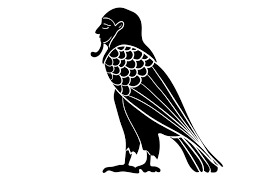
So what happened? Turns out the Late Dynastic Period ended in around 3100 BCE, or 5100 years ago, and the Old Kingdom lasted from around 2700-2200 BCE, or 4700-4200 years ago, which is a dumb long time ago. In that stretch of around 900 years, the saddle-billed stork went extinct in Egypt! The poor artists that were tasked with depicting the saddle-billed stork had never seen one before, so they decided to change the symbol. The legendary run of the saddle-billed stork hieroglyph, a run I think about every day, lasted three times longer than the existence of the United States, and ended over 2000 years before the birth of Jesus. Egypt was around for so long that our tiny brains cannot comprehend how long it existed.
https://www.jstor.org/stable/41812313?read-now=1&seq=11#page_scan_tab_contents
54 notes
·
View notes
Text

"An entertaining and informative introduction to how ancient Egyptians practiced magic in their daily lives.
In the ancient world, if you needed a love charm, wanted to contact your dead wife, or needed the ability to fly like a bird, the magicians of Egypt were the ones who could make it happen. In Ancient Egyptian Magic, Christina Riggs explores how the Egyptians thought about magic, who performed it and why, and also helps readers understand why we’ve come to think of ancient Egypt in such a mystical way.
Readers will learn how to cure scorpion bites, discover why you might want to break the legs off your stuffed hippopotamus toy, and uncover whether mummies really can come back to life. Readers can also learn how to save a fortune on pregnancy tests―urinating on barley grains will answer that question― as well as how to use the next street parade to predict the future or ensure that an annoying neighbor gets his comeuppance.
Was magic harmless fun, heartfelt hope, or something darker? Featuring demons, dream interpreters, the Book of the Dead, and illustrations from tomb paintings and papyrus scrolls, Riggs breathes new life into ancient magic and uses early texts and images to illuminate the distinctions between magic, religion, and medicine."
— Ancient Egyptian Magic: A Hands-On Guide, by Christina Riggs
108 notes
·
View notes
